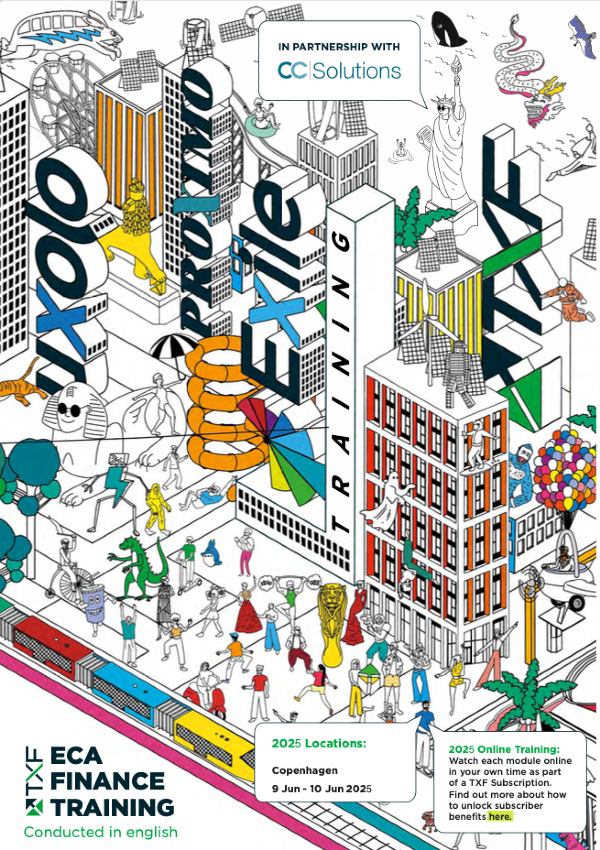Africa: A ballooning ECA debt space
ECA support is integral to getting several large-scale carbon-intensive projects across the financial line in sub-Saharan Africa this year, with social infra schemes also high on the financing agenda of agencies active on the continent.

Africa has played host to a raft of innovative big-ticket financings in the ECA market over the past few years. And deal flow continues apace. The news bodes well for the wider export finance community given increased ECA collaboration and flexibility has long been mooted as intrinsic to taking a more holistic approach to large-scale project finance deals on the continent.
DFIs will be paramount to unlocking private capital, and as development banks stretch to combat Covid and the climate change crisis, ECAs will also play a greater role in getting deals across the financial line.
African buyers – especially sovereign borrowers given ballooning debt piles on the continent – have struggled to drum up the 15% down payment financing traditionally needed for ECA-backed buyer credits given the private insurance market’s stifled response to residual risk on such deals due to the Covid-19 pandemic. But this private market stagnation spurred innovation.
Western African risk appetite
ECAs and banks have engineered bespoke structures to provide 100% cover, including Ghana’s MoF, which last year signed a pathfinder €600 million ($712 million) dual ECA-covered financing for the construction of a 100km section of the West African country’s Western Railway Line. Shortly after, lead arrangers on that deal – Deutsche Bank and Investec, with support from EKN and ECIC – closed a €215 million loan to finance two major hospital projects in Ghana.
Ghana’s MoF sealed another landmark ECA-backed social loan last year too – a €280 million ECA-backed social loan financing for the Eastern Corridor road project, and a €78 million UK Export Finance-backed financing deal for a project to design, construct, and equip the new Eastern Regional Hospital.
These deals provided viable financial templates for future such financings: and in January this year Ghana’s MoF signed a 13-year $199.75 million Serv-backed loan to back the construction of nine centres of excellence for Council for Technical and Vocational Education and Training (COTVET) across different locations in Ghana, alongside an ECA-backed facility to support construction of a new 400-bed maternity block at the Korle-Bu Teaching Hospital in Accra.
The latter deal demonstrates ECAs’ increasing appetite for Ghanian risk, with EKN providing 100% cover on a €147.4 million 13-year tranche with SEK as sole lender (in tandem with a €16.7 million five-year tranche solely provided by Afreximbank).
This year expect more MoF deals in Ghana, Senegal and a small-ticket bus deal in the Ivory Coast, alongside resumed discussion around the multi-billion dollar ECA/DFI-backed Rovuma LNG project in Mozambique – which was put in the fridge during the pandemic because of a military insurgence in the region.
Fossil fuels part of energy transition
Given the heightened energy security issues in the wake of the war in Ukraine, schemes such as Mozambique LNG and Rovuma are becoming more important to plugging Europe’s burgeoning gas supply issues. In fact, ECAs have completed evaluations on another large-scale scheme: TotalEnergies’ controversial $3.5 billion East African Crude Oil Pipeline (EACOP) project, with some bank commitments already in.
And in North Africa, Egypt’s state-owned oil refiner Assiut National Oil Processing Company sealed an innovative $1.5 billion ECA-covered loan to back the Assiut oil refinery expansion project. The deal has provided a viable financial blueprint for future projects without a sovereign guarantee to cover the entire financing. Again, plenty of ECA innovation.
So, as energy transition is now a buzzword baked into the mouths of government officials and policymakers, it is clear Africa still boasts plentiful oil and gas reserves which will help Europe plug its gas supply constraints. But there are still significant capacity issues for several gas rich countries on the continent – such as Algeria, Nigeria and Mozambique despite their plentiful reserve bases.
ECAs have not supported a deal in Algeria for over 15 years, for instance, and there is real potential for export finance, in tandem with DFIs, given this currently sanctioned market has not hosted any international financings for nearly two decades.
Domestically, annual investment of $25 billion would deliver universal energy access in Africa by the end of decade, according to the International Energy Agency (IEA), reversing a fall in electricity provision as a result of the economic impact of the Covid-19 pandemic and Russia’s invasion of Ukraine.
Speaking ahead of the release of the IEA’s African Energy Outlook 2022, Fatih Birol, executive director of the Paris-based energy body, said only about 7% of the total climate finance flows from advanced economies to developing countries goes to African nations.
In short, ECAs and DFIs will be needed to lay the seedbed to provide comfort to commercial banks eyeing up big-ticket infrastructure finance deals in Africa, from carbon-intensive schemes to renewable projects (of which there have only be a handful of ECA-backed deals in recent years).
Become a subscriber today to access the best export, trade and commodity finance analysis available. Email intelligence@txfmedia.com to find out more
Exclusive subscriber-only content published last week;
Ground net zero?
Growth of metals and rare earths mining is crucial to building out the renewables infrastructure required to meet the Paris climate goals. But short-termism and liquidity constraints in the mining sector is a major cause for concern for the renewables supply chain. Could energy majors provide the liquidity and experience that is needed to put metals and rare earths mining on a longer term investment footing?....Read on here
Is Term SOFR the new dollar Libor?
The global project finance market looks set to replace one forward-looking dollar benchmark interest rate with another. Is Term SOFR effectively USD Libor with a new lick of paint?....Read on here
The market for green loans & ESG-tied debt
There is a raft of different metrics to measure sustainability and the SDGs - LMA green loans, equator principles, ICMA bond principles and EU taxonomy, to name a few. But can one size ever fit all? And will ESG-tied debt ever be a viable product suite readily tapped by users of export finance?....Read on here
IfTI: Jansen on reforming OECD Consensus
TXF caught up with Marion Jansen, director of the trade and agriculture directerorate at the OECD to discuss where the Consensus on export credit can be further reformed, with a particular need for longer tenors, greater flexibility and updated sector agreements....Read on here
Banks in for EACOP financing
Some of the bank commitments backing TotalEnergies’ controversial $3.5 billion East African Crude Oil Pipeline (EACOP) project are in. ECAs on the deal – which include....Read on here
Limited emerging market issuances due, say syndicate lenders
Some emerging market (EM) lenders expect low new activity before the summer break, and what new business there is could coalesce around a smaller.....Read on here
Finnvera to support domestic manufacturing deal
Finnish ECA Finnvera is expected to cover a loan to finance the construction of a.....Read on here
Heaney new Acting Secretary General of Berne Union
Paul Heaney is stepping into the newly-created role of Acting Secretary General of the Berne Union, the international association of export credit and investment insurance.....Read on here
ADB issues EOIs to advisers for Manila solar PV
ADB has issued two expressions of interest (EoI) to prospective advisers for the development of a solar PV plant and a.....Read on here
Sponsors of the Ferrocarril Central rail PPP in Uruguay - Berkes, NGE, Saceem and Sacyr - have sealed a $2...Read on here
Neom Green Hydrogen bank commitments due end of next week
Sponsors of the Neom Green Hydrogen project in Saudi – Air Products, ACWA Power and Public Investment Fund (PIF)-owned Neom – have asked for....Read on here
Lordstown Energy refinanced
Sponsors of the 940MW Lordstown Energy Centre in Ohio – Macquarie Infrastructure Partners III US Energy Holdings (70%), Siemens Financial Services (26%) and Clean Energy Future, LLC (4%) – have...Read on here.
Additional information has come to light concerning the $392 million project financing of the 400MW Mammoth North solar PV project in Starke County, Indiana, USA......Read on here





